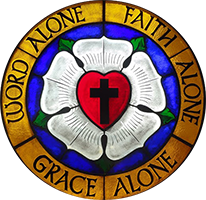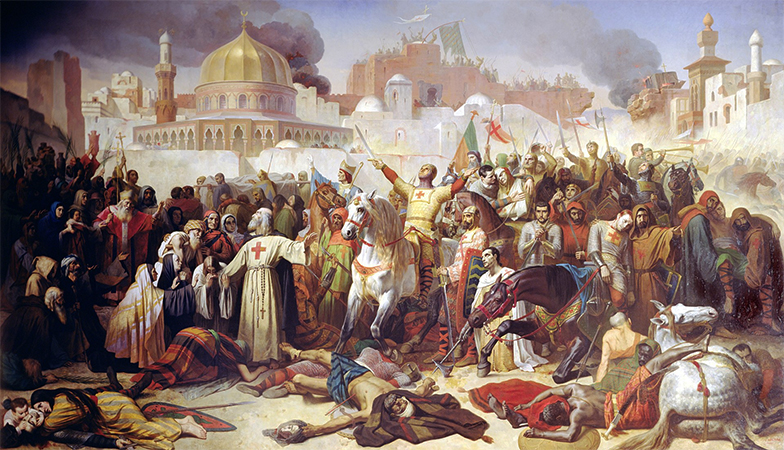The Rise & Fall of ...
... the Roman Empire ... ... and the Holy Roman Empire!
[After the fall of the Roman Empire, the] papacy began to wield tremendous secular power in the west. Beginning
in the eighth century, the approval of the papacy was sought as
conferring divine sanction on feudal kings. In the ninth century the
Church produced documents old and new believed to legitimate the
hierarchical authority of the papacy over the Church, and the Church
over society, as the proper means of transmitting inspiration from the divine to humanity. Those who disagreed could be threatened with excommunication. This exclusion from participation in the sacraments
was a dread ban, cutting a person off from the redemption of the Church
(blocking one’s entrance to heaven in the afterlife), as well as
from the benefits of the Church’s secular power.
Late in the eleventh century, Pope Gregory VII set forth
unprecedented claims for the papacy. The pope, he asserted, was
divinely appointed and therefore could be ruled by no human. The pope
had the right to depose emperors; the princes of the world should kiss
his feet. (Living Religions, 328)
How does this emphasis on the Seven Sacraments differ from
Matthew's conception of salvation through "works of law"?
Is this approach consistent with Paul's conception of salvation through "faith"?
|

 |
|
Problems in the Church?
From 1095 to about 1290, loosely organized waves of Christians poured out of Europe in what were presented as “holy crusades”
to recapture the holy land of Palestine from Muslims, and in general to
wipe out the
enemies of Christianity. ...

|
Martin Luther on the Crusades
The
popes have never seriously intended to wage war against the Turk;
instead they used the Turkish war as a cover for their game and robbed
Germany of money by means of indulgences. ... But what motivated me
most of all was this: They undertook to fight against the Turk in the
name of Christ, and taught and incited men to do this, as though our
people were an army of Christians against the Turks, who were enemies
of Christ. This is absolutely contrary to Christ’s doctrine and
name. ... This is the greatest of all sins and is one that no Turk
commits, for Christ’s name is used for sin and shame and thus
dishonored. This would be especially so if the pope and the bishops
were involved in the war, for they would bring the greatest shame and
dishonor to Christ’s name because they are called to fight against the
devil with the word of God and with prayer, and they would be deserting
their calling and office to fight with the sword against flesh and
blood. They are not commanded to do this; it is forbidden. (Martin Luther, On War Against the Turk, in Luther’s Works vol. 46, 164-5) |
When crusaders entered Constantinople in
1204, they destroyed the altar and sacred icons in Hagia Sophia, the
awesome Church of the Holy Wisdom, and
placed prostitutes on the throne reserved for the patriarch. Horrified
by such profanity, the Orthodox Church ended its dialogue with Rome and
proceeded on its own path, claiming to be the true descendant of the
apostolic Church. Despite periodic attempts at reconciliation the
Eastern and Western Churches are still separate. (Living Religions, 328-9)
The thirteenth century saw the power of the papacy placed behind the Inquisition,
an ecclesiastical court set up during the 1230s to investigate
and suppress heresy. This court was based on the concept that heretics
should be controlled for the
sake of their own eternal salvation. In some cases the medieval
inquisitors
had them tortured and burned to deter others from dangerous views. For
example, in northern Italy and southern France a sect arose that was
later called Cathari (the pure), for its members lived ascetically,
emphasizing poverty and mutual aid. Though similar to established
Christianity in organization and worship, the movement denied that
Jesus was the incarnation of God, and saw the spirit as good but matter
as bad. Such beliefs were proclaimed heretical by the papacy; the
Cathars, attacked by the Inquisition, disappeared. (Living Religions,
329-30)
Despite the genuine piety of individuals within
the Catholic Church, some who clashed with its authority claimed that
those in power seemed often to have lost touch with their own spiritual
tradition. With the rise of literacy and printing in the late fifteenth
century, many Christians were rediscovering early Christianity and
comparing it unfavorably with what the Roman Catholic
Church had made of it. Roman Catholic fundraising or church-building
financial activities were particularly criticized. These included indulgences (remission
of the punishment for sin by the clergy in return for services or
payments), the sale of relics, purchases of masses for the dead,
spiritual pilgrimages, and the earning of spiritual “merit”
by donating to the Church. (Living Religions, 333)
Are the above activities consistent with Jesus' teachings?
Should the Church be expected to embody the teachings of Jesus ...
or is it merely a "human" institution that is flawed due to "original sin"?
|

Most significant
among the reformists was Martin Luther (1483-1546).
Luther was a monk, priest, and Professor of Biblical Studies at
the
University of Wittenberg. He struggled personally with the question of
how one could ever do enough good to merit eternal salvation. Luther
was also disturbed by the moral corruption of his parishioners from the
selling of indulgences, through which people could gain the merit
accumulated in the church to decrease time in Purgatory
(the intermediate place of purifying suffering for those who were not yet sufficiently stainless to enter
heaven).
The Castle Church at Wittenberg housed an immense collection of relics, including what were believed to be hairs from the Virgin Mary and a thorn from the “crown” of thorns placed on Jesus’
head before he was crucified. This relic collection was deemed so
powerful that those who viewed them on the proper day and contributed
sufficiently to the Church could receive indulgences from the pope
freeing themselves or their loved ones from almost two million years in
Purgatory.
By intense study of the Bible, Luther began to
emphasize a different approach. Both Paul and St. Augustine could be
interpreted as saying that God, through Jesus, offered salvation to
sinners in spite of their sins. This salvation was offered by
God’s grace alone and received solely by repentant faith. The
good works and created graces prescribed by Catholics to earn merit in
heaven were not part of original Christianity, Luther argued. Salvation
from sin comes from faith in God, which itself comes from God, by
grace. This gift of faith brings justification (being found righteous
in God’s sight) and then flowers as unselfish good works, which
characterize the true Christian:
| From
faith flows love and joy in the Lord, and from love a joyful, willing
and free mind that serves one’s neighbor willingly and takes no account
of gratitude or ingratitude, of praise or blame, of gain or loss. ...
As our heavenly father has in Christ freely come to our help, we also
ought freely to help our neighbor through our body and its works, and
each should become as it were a Christ to the other. |
In
1517 Luther invited the university community to debate this issue with
him, by the established custom of nailing his theses to the door of the
church. He apparently had no intention of splitting with the Church.
Nevertheless, he refused to recant passages from his theses when
threatened with excommunication. He was thenceforth excommunicated by a
papal bull (decree) in 1521.
Luther’s
evolving theology took him farther and farther from the institutions of
the Roman Catholic Church. He did not think that the Bible supported
the Catholic teaching on the importance of pope, bishops, priests, and
monks to mediate between God and laypeople. Instead, he emphasized that
there is “a priesthood of all believers.” He also felt that the sacred
rites, or sacraments, of the Church were ways of nourishing faith
instituted by Jesus and that they inlcuded only baptism and the
Eucharist (also known as the Lord’s Supper, Holy Communion, or Mass). (Living Religions, 333-4)
| One thing and one only is necessary for
Christian life, righteousness and liberty. That one thing is the most
holy Word [i.e. the logos, Jesus Christ] of God, the Gospel of Christ. ... The Word of God cannot be
received and cherished by any works whatever, but only by faith. Hence
it is clear that, as the soul needs only the Word for its life and
righteousness, so it is justified by faith alone and not by any works;
for if it could be justified by anything else, it would not need the
Word, and therefore it would not need faith. But this faith cannot at
all exist in connection with works, that is to say, if you at the same
time claim to be justified by works, whatever their character; for that
would be to halt between two sides, to worship Baal and to kiss the
hand, which, as Job says, is a very great iniquity. (An Anthology of Living Religions, 237) |
Is Luther's perspective in line with that of Paul, Matthew, and/or the early Church?
If one is saved by "faith", what is the role of "works"?
|
|
